Vikings
Description
Contents
- 1 Introduction to the Volatile Vikings
- 2 ☠️ The History and Legacy of the Vikings
- 3 ️ Characteristics of the Volatile Vikings
- 4 The Influence of the Vikings on Modern Culture
- 5 Exploration and Conquest: The Viking Age
- 6 The Vikings in Myth and Folklore
- 7 Sports and Recreation: The Viking Connection
- 8 Viking Architecture and Artistry
- 9 Education and Learning: The Viking Perspective
- 10 The Legacy of the Volatile Vikings in Today’s World
In the annals of history, the Vikings stand as a testament to the indomitable spirit of a people who left an indelible mark on the world. As the Norsemen roamed the seas, their legacy has woven itself into the fabric of modern culture, influencing language, literature, and even the very concept of heroism. This narrative delves into the multifaceted impact of the volatile Vikings, exploring their seafaring adventures, mythological tales, and the enduring legacy that continues to resonate through the ages.
Introduction to the Volatile Vikings
The Volatile Vikings, a term that evokes images of fierce warriors and relentless explorers, represent a pivotal era in history. These seafaring people, known for their adaptability and resilience, left an indelible mark on the world. Their legacy is a tapestry woven with tales of bravery, conquest, and cultural exchange.
In the heart of the Norse mythology, the Vikings were seen as gods’ chosen warriors, destined for glory and adventure. Their reputation as fierce fighters was well-earned, as they engaged in constant battles and raids across Europe. Yet, beneath the warrior’s armor lay a people with a rich culture, intricate social structures, and a profound connection to the natural world.
The Vikings were master mariners, navigating the treacherous waters of the North Atlantic and beyond. Their longships, designed for speed and agility, were the epitome of naval engineering. These vessels allowed them to venture far and wide, establishing colonies and trading posts in places as distant as North America and the Middle East.
Their society was organized into tribes, each with its own leader and social hierarchy. The Viking code of honor, known as the “Hávamál,” emphasized bravery, loyalty, and respect for one’s word. This code shaped the behavior of the Vikings, both in battle and in daily life.
The Viking age, spanning from the late 8th to the late 11th century, was a time of expansion and conquest. The Vikings were not just warriors; they were also traders, settlers, and explorers. Their raids on Christian monasteries were infamous, but they also engaged in peaceful trade and diplomacy.
One of the most remarkable aspects of the Vikings was their adaptability. They were able to thrive in diverse environments, from the harsh tundra of Scandinavia to the fertile lands of England and France. Their ability to adapt their culture and practices to new territories was a testament to their resourcefulness.
The Viking society was also known for its gender equality. Women held significant positions of power and influence, including the role of “thralls,” which was not necessarily a form of slavery but rather a social class. Women could own property, engage in trade, and even serve as leaders in some cases.
The Vikings were also great builders and artists. Their wooden longhouses, stave churches, and runestones are testaments to their craftsmanship and aesthetic sensibilities. The runic alphabet, developed by the Vikings, became a symbol of their culture and a means of preserving their history.
In the realm of mythology, the Vikings were the stuff of legends. Figures like Ragnar Lodbrok, the god-like hero, and his sons, such as Björn Ironside and Ivar the Boneless, were the stuff of Norse sagas. These tales, passed down through generations, have shaped the Viking image in popular culture.
The Vikings’ influence on modern culture is profound. From the depiction of the “Viking” in film and television to the use of the term “Viking” in various contexts, their legacy is ever-present. The popularity of Viking-themed games, such as “Assassin’s Creed: Valhalla,” further cements their place in the cultural consciousness.
The exploration and conquest of the Viking age were not just about land and power; they were about the quest for knowledge and the unknown. The Vikings’ encounters with new peoples and cultures led to a rich exchange of ideas and goods. This period of interaction laid the groundwork for the interconnectedness of the modern world.
The Volatile Vikings, with their fiery spirit and relentless pursuit of adventure, have left an enduring legacy. Their impact is felt in the languages, laws, and cultures of the regions they touched. The Viking spirit, characterized by bravery, innovation, and a sense of freedom, continues to inspire people around the world.
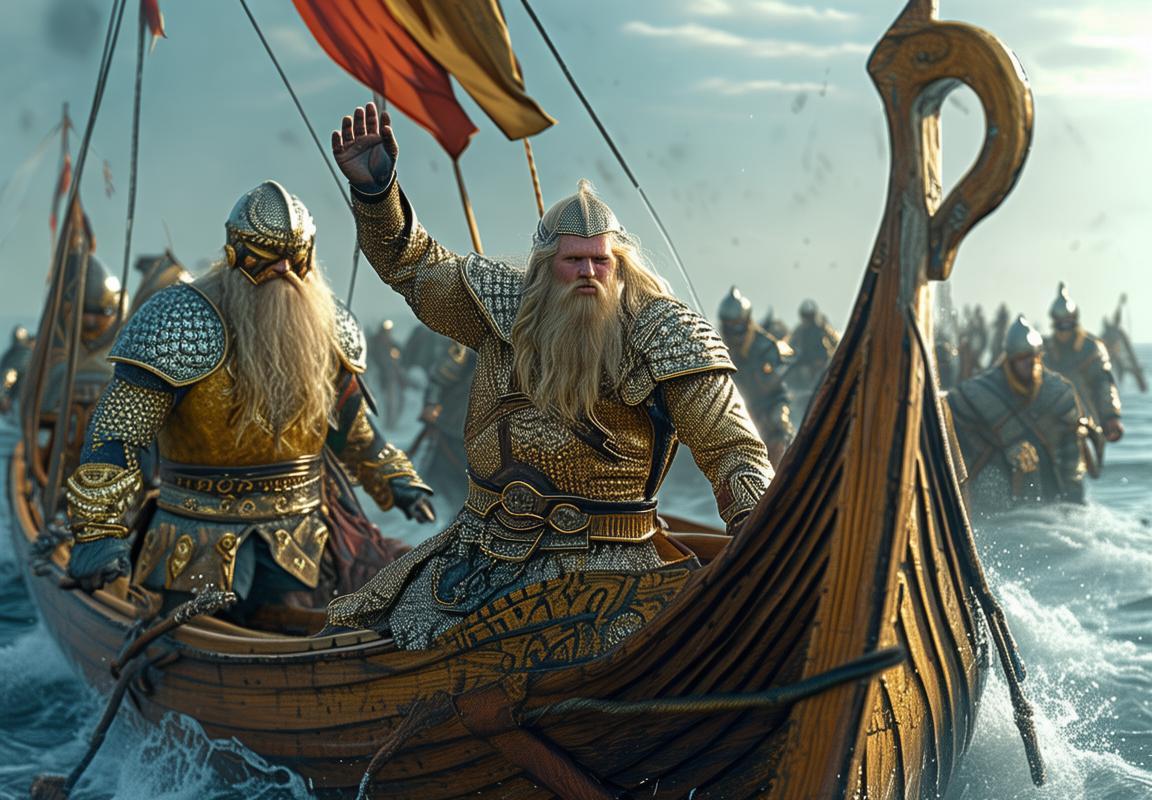
☠️ The History and Legacy of the Vikings
The Volatile Vikings, a term that evokes images of fierce warriors and intrepid explorers, have left an indelible mark on history. Their legacy spans centuries, and their influence can still be felt today. 🏴☠️
The Viking Age, spanning from the late 8th to the late 11th century, was a period of significant expansion and conquest. These seafaring people, originating from the Scandinavian region, embarked on expeditions across the North Atlantic, the North Sea, and even as far as the Mediterranean. Their reputation for bravery and skill in battle was unmatched, and they were known for their swift longships that could navigate the treacherous waters with ease.
Their legacy is not just in the tales of battles won and lands conquered, but also in the cultural and linguistic impact they left behind. The Vikings introduced Old Norse to the regions they occupied, which would later evolve into modern languages such as Icelandic, Faroese, and Norwegian. 📜
The term “Volatile Vikings” suggests a sense of unpredictability and changeability, which is indeed a fitting description. The Vikings were not a monolithic group; they were a diverse society with varying customs, beliefs, and practices. Their society was dynamic, with constant shifts in leadership, alliances, and conflicts. This volatility is evident in their migration patterns, which saw them settle in various parts of Europe, including England, France, and Russia.
One of the most notable aspects of Viking history is their love for exploration. They were among the first Europeans to reach North America, predating Christopher Columbus by several centuries. Their voyages were not merely for conquest but also for trade, knowledge, and the spread of their culture. The Norsemen were skilled navigators, using the stars and the sun to guide their ships across vast distances. 🌍
The Viking society was also known for its craftsmanship and innovation. They were master builders, constructing impressive stone cathedrals, wooden longhouses, and even the famous Viking ships. Their shipbuilding techniques were advanced, and their longships were designed for speed and maneuverability, allowing them to venture into unknown territories with relative ease.
In addition to their military prowess, the Vikings were also traders and merchants. They established trading posts and settlements in various parts of Europe, which helped to foster cultural exchange and economic growth. The Norsemen were known for their craftsmanship in metalworking, particularly in silver and goldsmithing, which became highly sought after in the regions they traded with.
The Viking society was also marked by a strong sense of family and kinship. The concept of the “Viking clan” was central to their social structure, with close ties between family members and a shared sense of identity. Their culture placed a high value on personal honor and the ability to fight, which is reflected in their sagas and epics, such as the “Vikings of the Sea” and “Eirik the Red’s Saga.”
The Viking legacy is also evident in the laws and governance systems they introduced. The “Viking Law” or “Lex Scandina” was a set of legal codes that influenced the legal systems of many European countries. These laws were based on the principle of equality before the law and provided a framework for resolving disputes and maintaining order in Viking society.
The influence of the Vikings can be seen in the languages, literature, and even the names of places they once occupied. For example, the word “doughnut” is believed to have originated from the Old Norse word “hlesse,” which means “oil cake.” The term “Viking” itself has become synonymous with adventure and the spirit of exploration.
The Volatile Vikings were a people who defied easy categorization. They were warriors, explorers, traders, and innovators, all in one. Their legacy is a testament to their adaptability and resilience, as well as their enduring impact on the world. Their story continues to captivate the imagination of people around the globe, reminding us of the power of human determination and the indomitable spirit of adventure. 🏰
The Viking Age was a time of profound change, and the Vikings themselves were change agents. They brought with them new ideas, new technologies, and a new way of life. Their legacy is not just in the ruins of their castles and the artifacts they left behind but in the very fabric of the societies they touched. The Volatile Vikings remind us that history is not static, but a living, breathing entity that continues to shape our world today. 📚 PG electronic game APP download
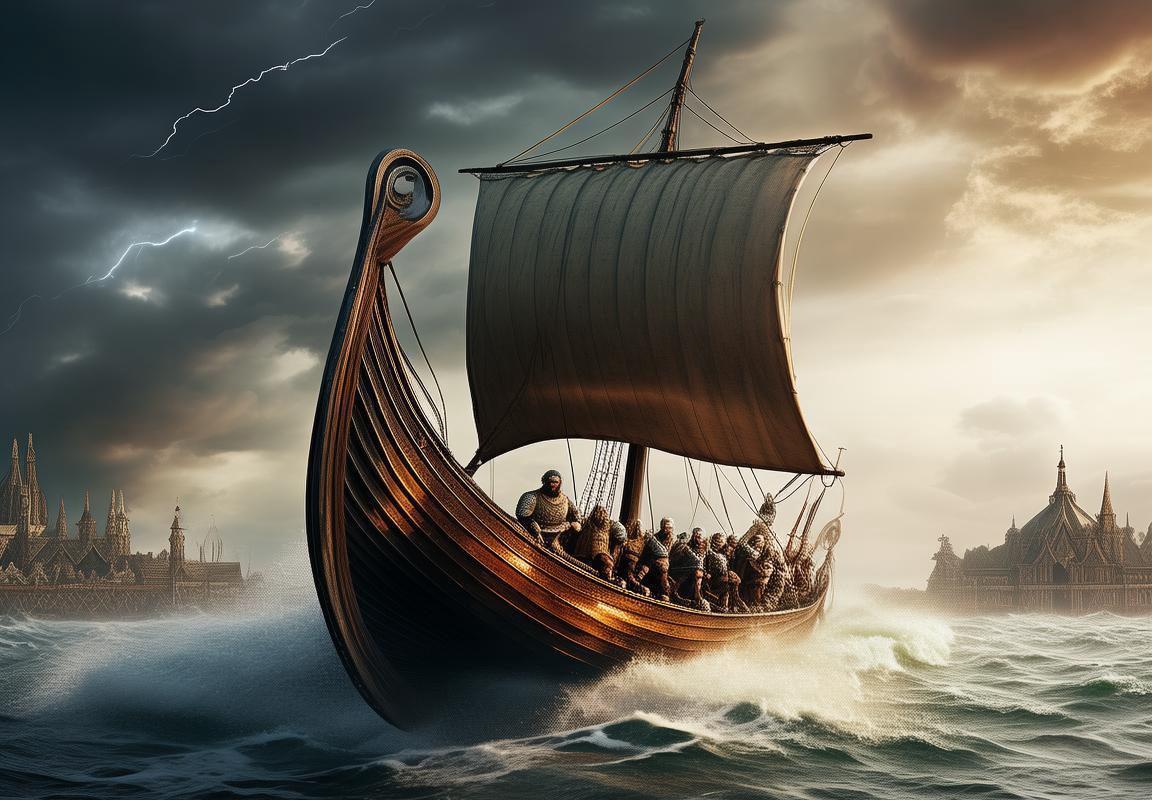
️ Characteristics of the Volatile Vikings
The Volatile Vikings were a formidable force in history, known for their prowess in battle and their relentless pursuit of adventure. 🏴☠️ Here are some of the key characteristics that defined these legendary warriors:
——Vikings were renowned for their exceptional martial skills, which were honed through constant training and combat. They were adept at using a variety of weapons, including the longsword, spear, and the iconic battle-axe, known as the “Berserker.” Their physical strength and agility were matched by their strategic acumen on the battlefield. 🗡️
——The Vikings were master seafarers, navigating the treacherous waters of the North Atlantic and beyond. Their longships, designed for speed and agility, were the epitome of naval engineering. These vessels allowed them to embark on daring raids and explorations, often leaving their mark on distant lands. Their seafaring skills were not just for warfare but also for trade and diplomacy. 🚢
——A defining trait of the Vikings was their adaptability. They were not confined to a single region or culture; instead, they were a diverse group of people who absorbed and merged various traditions as they traveled. This inclusivity was evident in their society, where slaves could rise to positions of power, and women had more rights than in many other contemporary societies. 🌍
——The Vikings were fiercely loyal to their kin and often formed tight-knit bands, known as “healing bands,” that traveled together and protected each other. This sense of camaraderie was crucial in their survival and success, as they faced numerous challenges on their journeys. Their social structures were also marked by a strong emphasis on personal honor and reputation. 🤝
——The Viking warriors were known for their ferocity in battle, a trait that was often exaggerated in myths and legends. The Berserker warriors, in particular, were said to enter a state of madness, losing all sense of fear, and fought with an unmatched ferocity. However, this image may have been a distortion of their actual behavior, as evidence suggests they were disciplined soldiers. 🔥
——Vikings were also highly skilled artisans and craftsmen. They excelled in metalworking, creating intricate jewelry, weapons, and tools. Their craftsmanship was not limited to metal; they were also adept at woodworking, creating everything from boats to furniture. This versatility in their skills allowed them to thrive in a variety of environments. 🛠️
——The Viking society was structured around a system of laws known as the “Gulag,” which governed the behavior of individuals and the rules of society. These laws were designed to maintain order and were often enforced by the local jarl or chief. The Vikings were a law-abiding people, and their respect for the rule of law was a key factor in their success. 📜
——Viking society was also characterized by a strong sense of community and shared resources. The concept of “thralldom” allowed for a form of communal living where land and resources were shared among the members of a village or clan. This system promoted cooperation and ensured that everyone had access to the necessities of life. 🏠
——The Vikings were not just warriors; they were also traders and explorers. Their interactions with other cultures led to the exchange of goods, ideas, and knowledge. This exchange of goods included valuable commodities such as furs, spices, and precious metals, which enriched their societies. Their exploration also brought them into contact with the Byzantine Empire, the Islamic world, and other European kingdoms. 🌐
——The legacy of the Volatile Vikings is one of resilience and innovation. Despite their relative short existence as a distinct cultural entity, their impact on history is profound. They left behind a rich tapestry of cultural heritage, including the Norse mythology, which continues to influence literature, film, and popular culture today. 📚
——The Viking age was a time of great change and transformation. Their aggressive expansionist policies, while often seen as brutal, also brought about a period of cultural exchange and growth. The Vikings’ legacy is not just in the land they conquered but in the way they shaped the world through their actions and interactions. 🌍
——In summary, the Volatile Vikings were a complex and fascinating people. Their characteristics, from their martial prowess to their adaptability and craftsmanship, have left an indelible mark on history. Their legacy continues to inspire and challenge us, reminding us of the power of human ingenuity and the enduring nature of cultural heritage. 🏴☠️
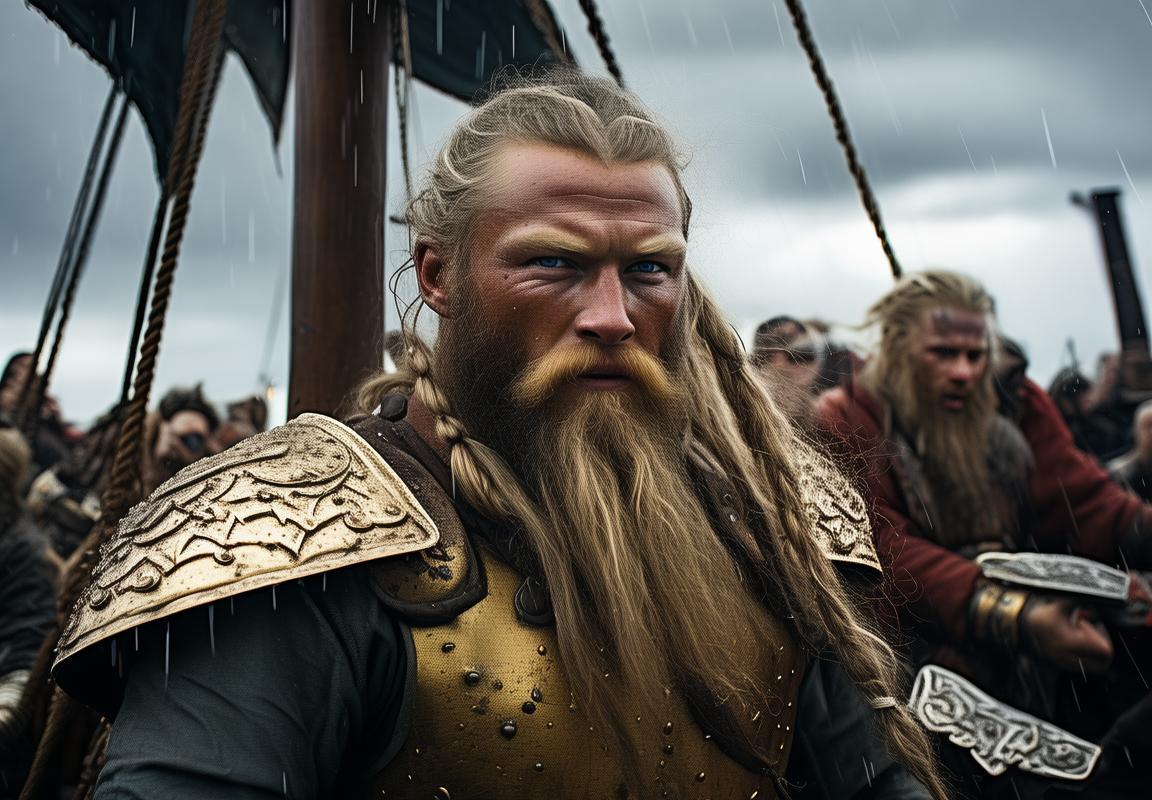
The Influence of the Vikings on Modern Culture
Vikings, once feared and revered, have left an indelible mark on modern culture. Their influence can be seen in various aspects, from language to literature, and even in modern-day practices. Here’s how the Volatile Vikings have shaped the world we live in today:
📚 Language and WordsThe Viking era has contributed numerous words to the English language, reflecting their seafaring prowess, warrior culture, and social customs. Words like “berserk,” “skuld,” “axeman,” and “viking” itself are direct descendants of the Old Norse language. The term “viking” originally referred to the people’s practice of raiding and trading, which has since evolved to describe a type of ship and, by extension, a spirit of adventure.
🌐 Nautical ExpertiseThe Vikings were renowned for their mastery of the sea. Their longships, with their shallow drafts and high speed, allowed them to navigate coastal waters with ease. This nautical expertise has inspired modern designs and technologies in marine engineering. The sleek lines and innovative construction of today’s yachts and racing boats often echo the design principles of Viking longships.
🏰 Architecture and ConstructionThe Vikings left their mark on architecture, particularly in Scandinavia. The stave churches, with their distinctive wooden structures and ornate carvings, are a testament to their craftsmanship. While the Viking era has passed, their influence is still evident in modern Scandinavian design, which emphasizes simplicity, functionality, and natural materials.
🎨 Art and IconographyThe Viking art, characterized by its boldness and intricate detailing, has influenced contemporary artists. The runic alphabet, used for inscriptions on artifacts, has been a source of inspiration for graphic designers and typographers. The use of runes in modern art and design reflects a nod to the Viking heritage and their respect for the written word.
🏋️♂️ Sports and RecreationThe Vikings had a love for physical prowess, which is evident in modern sports. The Norse games, which included contests like foot races, wrestling, and strength competitions, have parallels in today’s sports. The Viking ethos of honor and excellence in physical endeavor can be seen in the rigorous training and competitive spirit of athletes worldwide.
🎭 Myth and FolkloreViking legends and tales have been woven into the fabric of modern myth and folklore. Characters like Beowulf, a warrior who battles monsters, draw inspiration from the Viking warrior ethos. The “Viking” as a stereotype has persisted in popular culture, with various films, television shows, and video games featuring characters that embody the traits of the legendary Norsemen.
📚 Literature and FictionAuthors have drawn on Viking history and mythology to create compelling narratives. Books like “The Lord of the Rings” and “Mistborn: The Final Empire” incorporate elements of Viking culture and the concept of the “rune” as a magical symbol. The enduring appeal of Viking lore ensures that these stories continue to resonate with readers across generations.
🏰 Media and EntertainmentThe Viking legacy is well-represented in the media and entertainment industry. From the “Vikings” television series that captures the essence of the Viking age to the use of Viking imagery in video games and animated series, the influence of the Volatile Vikings is undeniable. These depictions often romanticize the past, presenting a version of Viking life that is both exciting and heroic.
🎨 Fashion and DesignViking-inspired fashion has seen a resurgence in recent years, with designers drawing inspiration from the rich tapestry of Norse history. The use of traditional Viking patterns, motifs, and materials in modern clothing and accessories reflects a blending of past and present, showcasing the enduring influence of the Viking aesthetic.
🌍 Cultural IdentityThe Viking legacy has played a significant role in shaping the cultural identity of Scandinavian countries. Celebrations like the Viking Festival in York, England, and the Viking Ship Museum in Roskilde, Denmark, are dedicated to preserving and celebrating Viking heritage. These cultural events foster a sense of pride and connection to the past.
In summary, the Volatile Vikings have left an enduring impact on modern culture. From the language we speak to the art we admire, the legacy of these intrepid seafarers continues to inspire and influence the world we live in today.
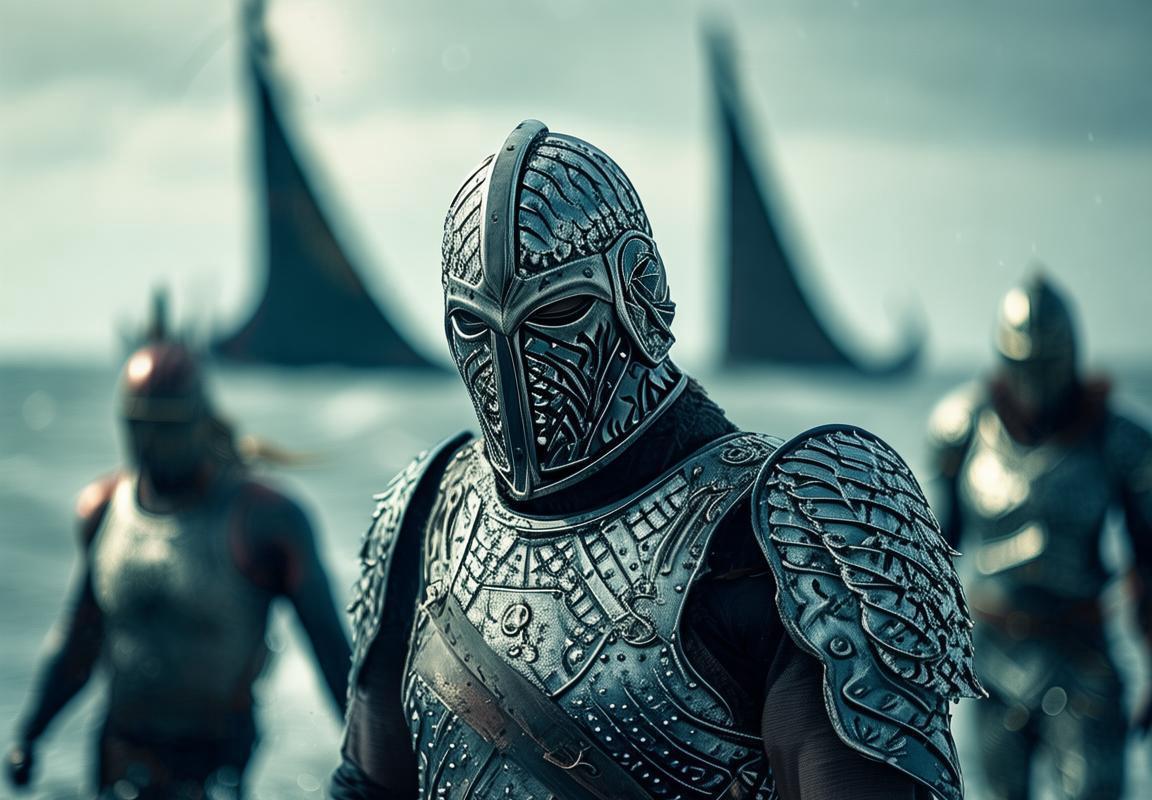
Exploration and Conquest: The Viking Age
🌍 The Viking Age was a time of relentless exploration and bold conquest, a period marked by the expansionist ambitions of a people known for their ferocity and ingenuity. These Norse warriors, known as Vikings, left an indelible mark on the history of Europe and beyond. Their legacy is woven into the fabric of our modern world.
🏴☠️ The Vikings were a seafaring people who thrived on the coasts and fjords of what is now Scandinavia. Their longships, designed for speed and maneuverability, were the epitome of naval engineering. These vessels allowed the Vikings to venture far beyond their home territories, reaching as far as the Mediterranean, the North Atlantic, and even the North American coast.
🚢 Their expeditions were not merely for trade, though that was a significant part of their activities. The Vikings were also raiders, pillagers, and traders, often blending these roles in their ventures. They targeted monasteries, which were rich in wealth and often poorly defended, for their treasures. The famous Battle of Reading in 871, where the Vikings defeated the Anglo-Saxons, is a testament to their martial prowess.
🏰 The Viking Age was a time when the concept of a feudal society was taking root in Europe. The Vikings were adept at exploiting this system, establishing their own kingdoms and principalities across the lands they conquered. They brought with them a form of governance that was often more pragmatic and less hierarchical than the existing structures in their new territories.
🌊 The exploration and conquest of the Viking Age were not confined to Europe. They ventured into the British Isles, where they established the Danelaw in parts of England. They also founded the Norse settlements in Iceland, Greenland, and even ventured as far as Newfoundland in North America. These settlements were often short-lived, but they demonstrated the Vikings’ ability to adapt to new environments and thrive where others had failed.
🗡️ The Vikings were not just warriors; they were also skilled artisans and builders. Their craftsmanship in metalwork was exceptional, and they were known for their intricate designs in jewelry and tools. The architecture of the Viking Age, such as the stave churches in Norway, showcases their ability to create lasting structures that still stand today.
📜 The Viking Age also saw the development of a rich literary tradition, much of which was preserved in the form of runes. The Eddas, including the Poetic Edda and the Prose Edda, are among the most significant texts from this period. These works offer insight into Viking mythology, their beliefs, and their worldview.
🌐 The Viking Age was a time of significant cultural exchange. The Vikings brought back knowledge from their travels, which influenced the art, language, and law of the regions they occupied. In turn, the cultures they encountered shaped their own. For example, the Christianization of Scandinavia was partly due to the influence of the Viking conquests.
🌍 The legacy of the Viking Age is evident in the many place names across Europe that still bear the mark of their presence. From York in England to Nidaros in Norway, the names reflect the areas once controlled by Viking rulers. The term “Viking” itself has become synonymous with adventure and courage.
🏹 The Vikings’ love for sports and games is also a testament to their cultural legacy. They were known for their skill in various sports, including football (soccer) and a form of handball called knattleik. These games were not just for entertainment but were also a way to train for combat and build community spirit.
📚 The influence of the Viking Age continues to resonate in modern culture. From the depiction of Vikings in literature and film to the fascination with Norse mythology, the legacy of the Vikings is a vibrant part of our collective imagination. The popularity of games like “The Witcher” and the “Vikings” TV series are just a few examples of how their story continues to captivate audiences today.
🌟 The Viking Age was a time of exploration, conquest, and cultural exchange. The Volatile Vikings left an enduring mark on the world, one that is still felt and celebrated in many ways today. Their legacy is a reminder of the power of human ambition and the indomitable spirit of exploration.
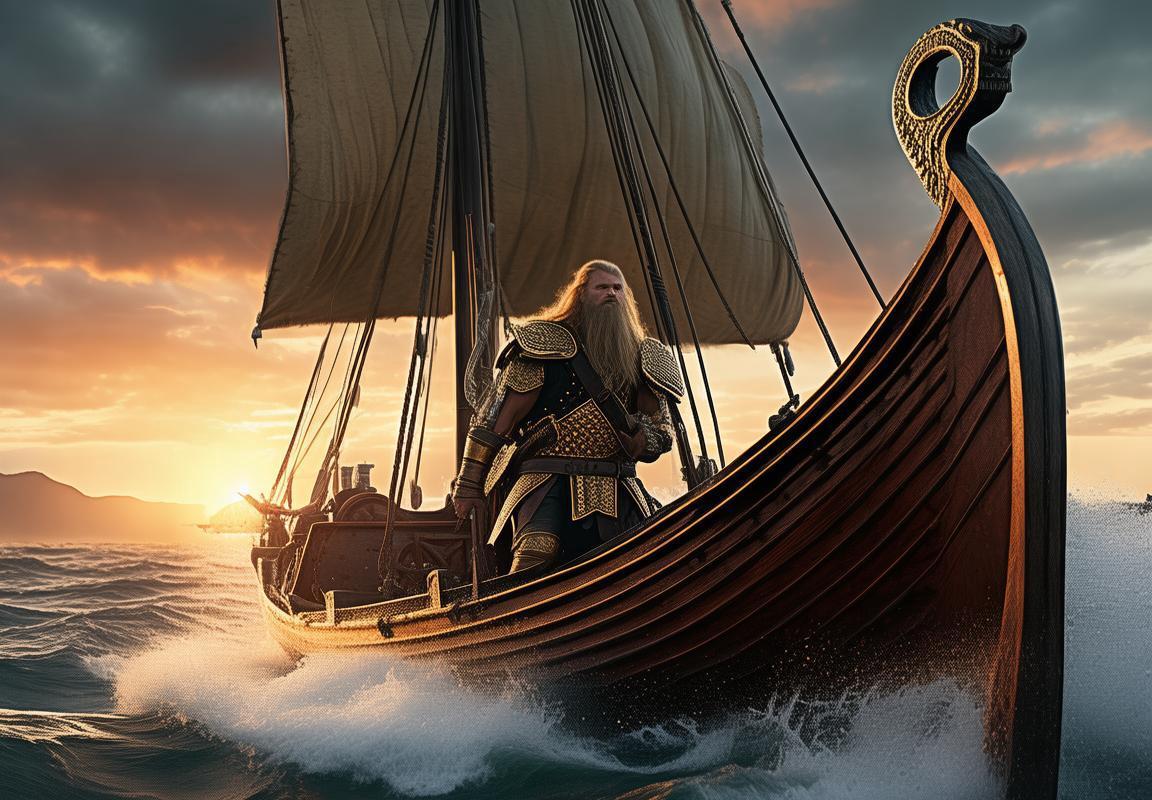
The Vikings in Myth and Folklore
Vikings have long been woven into the fabric of myths and folklore, leaving an indelible mark on the stories that have been passed down through generations. 🌟
Their reputation as fearsome warriors has been immortalized in tales, but the Vikings were much more than just the legendary berserkers of medieval legend. 🏹
From the Norse sagas to the Scandinavian tales, the Vikings have become synonymous with bravery, cunning, and a relentless spirit. 📚
One of the most enduring myths surrounding the Vikings is their seafaring prowess. 🚢
Legends speak of their longships, sleek and swift, capable of navigating the treacherous waters of the North Atlantic. These stories often depict the Vikings as relentless raiders, pillaging and plundering wherever they went. 🏴☠️
However, the reality was a bit more complex. While the Vikings were indeed warriors, they were also traders and explorers. 🌍
Their voyages took them across Europe, the Middle East, and even to North America, where the Norse settlements of Vinland are a testament to their adventurous spirit. 🌿
The Norse sagas, such as the “Vikings” and the “Edda,” are rich with tales of heroes like Ragnar Lodbrok, Björn Ironside, and Sigurd. 🏹
These stories often reflect the Viking values of loyalty, courage, and a deep connection to their gods and ancestors. 🌟
In many of these tales, the Vikings are portrayed as shape-shifters and sorcerers, with the ability to control the elements and the fates of others. 🌪️
One of the most famous examples is the story of Freyr, a god who can change his shape at will and whose chariot is pulled by two magical cats. 🐾
The Viking gods, including Odin, Thor, Freya, and Loki, have become part of the collective consciousness, influencing everything from literature to modern media. 📺
In Norse mythology, Odin is often seen as the king of gods, a wise and powerful figure who sought knowledge and wisdom above all else. 🤴
He is known for hanging upside down from the world tree, Yggdrasil, to gain wisdom, and for sacrificing an eye to gain knowledge. 🌳
Thor, on the other hand, is the god of thunder and battle, known for his hammer Mjölnir, which he wields with great strength. 🛡️
Freya, the goddess of love, beauty, and fertility, is often associated with the sacred ship Skidbladnir, which can carry her and all her possessions across the sea in a single night. 🚢
The stories of the Vikings in myth and folklore have also had a significant impact on the English language. 📚
Many words we use today have their roots in Old Norse, including words related to seafaring, warfare, and social customs. 📜
For example, the word “berserker” comes from the Old Norse “berserkr,” which describes a warrior who fights in a state of frenzy, often bare-chested and covered in bear skins. 🐻
Similarly, the term “viking” itself has become synonymous with adventure and exploration. 🌍
The Vikings’ influence on modern culture is also evident in the depiction of their lives and customs in contemporary works. 🎨
From the popular TV series “Vikings” to the numerous movies and books that feature the Norsemen, the image of the Viking continues to captivate audiences. 🎬
The fascination with the Vikings has also led to a renewed interest in Norse mythology and its impact on Western culture. 📚
In the world of fantasy literature, the Vikings have been adapted and reimagined in countless ways, from J.R.R. Tolkien’s “The Lord of the Rings” to George R.R. Martin’s “A Song of Ice and Fire.” 📖
The legends of the Vikings have become a part of our cultural heritage, reminding us of the bravery and resilience of a people who once roamed the seas in search of new lands and adventures. 🌊
As the stories of the Vikings continue to evolve, they serve as a reminder that the past can shape the present and influence the future in ways we may never fully understand. 🕰️
The legacy of the Vikings in myth and folklore is a testament to the power of storytelling and the enduring impact of a culture that once ruled the waves. 🌊
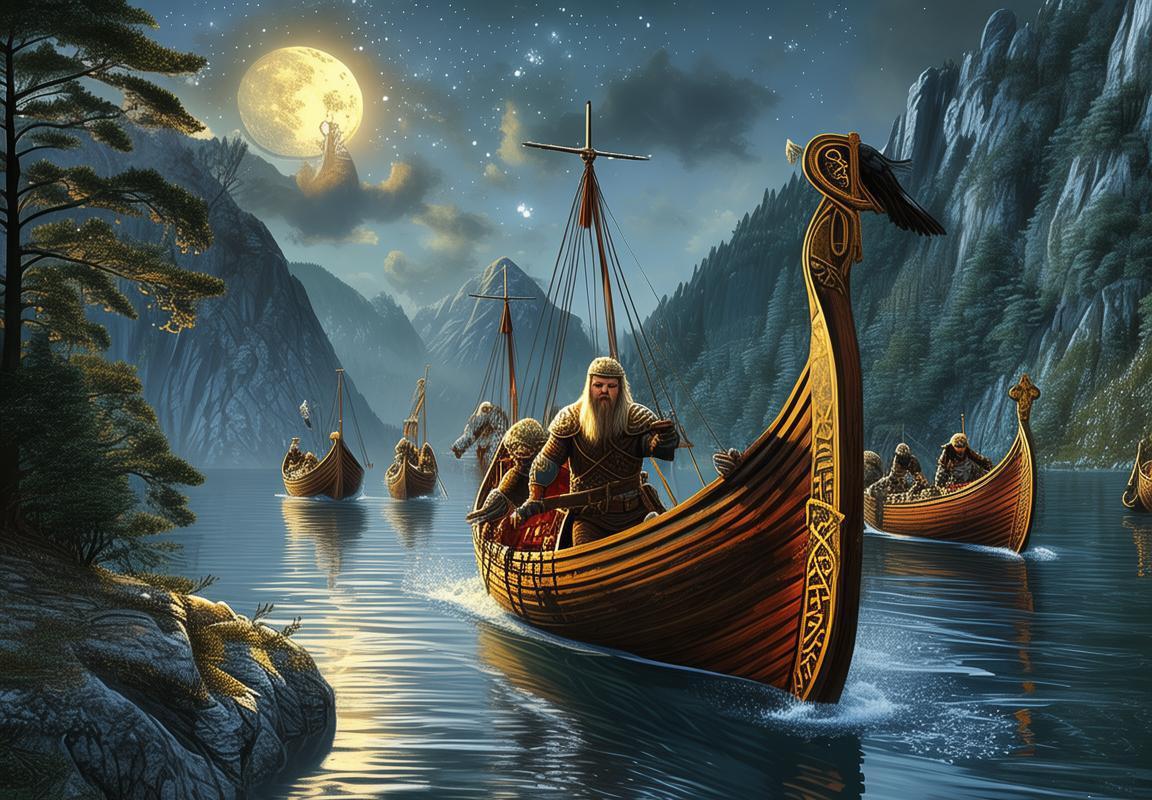
Sports and Recreation: The Viking Connection
The Viking era was marked not only by their prowess in warfare and exploration but also by a lively and varied culture that included sports and recreational activities. These activities served as a means for social cohesion, physical fitness, and entertainment. From combat games to ball sports, the Vikings had a range of activities that reflect their robust and adventurous spirit.
🏋️♂️ Physical Endurance and Combat Training
One of the key aspects of Viking life was the need for physical strength and resilience. This was evident in their rigorous training regimes, which often involved physical exercises. One such exercise was the “mæðrhamarr,” a type of Viking wrestling that was a precursor to modern Greco-Roman wrestling. This form of wrestling tested not just strength but also skill and strategy. Vikings would engage in these matches to hone their combat abilities, ensuring they were prepared for both battle and the rigors of daily life.
🏆 Team Sports and Competitive Play
Team sports were also a part of Viking culture. One such game was “knattleik,” a predecessor to the modern game of football. The game involved two teams kicking a ball, which was typically a leather pouch filled with animal hide. The objective was to kick the ball into a goal. This game was played on a field with marked boundaries, and it was a way for the Vikings to bond as a community and test their teamwork.
🥊 Martial Arts and Self-Defense
In addition to wrestling, the Vikings practiced martial arts, which were a blend of fighting techniques and physical conditioning. These martial arts forms were essential for self-defense and were often part of a Viking’s daily routine. One such technique was “hamborgar,” which involved grappling and joint locks, similar to Brazilian Jiu-Jitsu. The Vikings would engage in these exercises to stay agile and to have a ready defense in case of an attack.
🏰 Royal Games and Entertainment
Even within the confines of the Viking kingdom, games were used for entertainment and as a means to honor the king. “Hrollag”, for example, was a royal game where the king would lead a series of competitions, which could include everything from combat to sports. These games were often lavish and extravagant, with participants wearing fine garments and competing for the king’s favor.
🏕️ Outdoors and Nature-Based Activities
The Vikings were not just warriors but also explorers, and many of their recreational activities were closely tied to the outdoors. Hunting and fishing were common pastimes, not only for sustenance but also for leisure. The skill in these activities was often seen as a testament to a man’s strength and hunting prowess.
🌿 Herbal Remedies and Sports Injuries
As part of their sports and recreational activities, the Vikings also had a rudimentary understanding of herbal medicine. Athletes, including those involved in combat sports, would seek out healing herbs and remedies for any injuries sustained during play. This reflects the Viking’s pragmatic approach to health and wellness, combining physical activity with natural remedies.
🏃♂️ Community Games and Festivals
The Viking community also organized communal games and festivals where they could gather to participate in sports and recreational activities. These events were often held during the warmer months, when the days were longer and the weather was more favorable. Such gatherings would foster camaraderie and strengthen community bonds, as participants from various parts of the kingdom came together to compete.
🏮 Cultural Evolution and Influence
The legacy of Viking sports and recreation can be seen in the development of various sports that are now part of modern society. While many of these sports have evolved significantly, their origins can be traced back to the Viking age. For example, the Viking tradition of ball sports may have contributed to the evolution of modern soccer and handball.
🏡 Modern Sports and Viking Heritage
Today, the legacy of the Vikings continues to influence sports and recreational activities. The spirit of competition, physical fitness, and the enjoyment of play are all traits that the Vikings embraced and passed down through generations. Whether it’s through the design of sports equipment, the way games are played, or the values instilled in athletes, the Viking connection to sports remains a vivid part of our cultural heritage.
In summary, the Viking connection to sports and recreation is a testament to their multifaceted culture. It highlights their commitment to physical fitness, teamwork, and the joy of play, all of which are values that resonate with us even today. Through the lens of their sports and leisure activities, we can better understand the spirit of the Vikings and their enduring impact on the world.
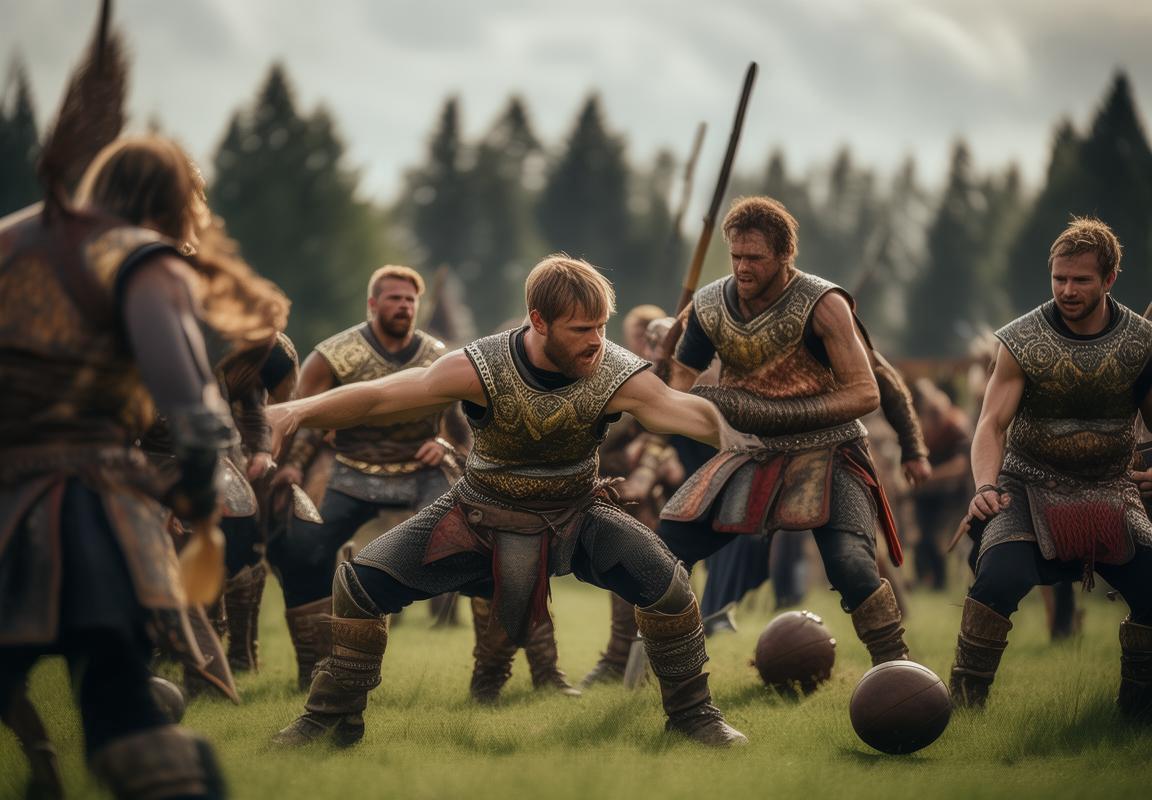
Viking Architecture and Artistry
Vikings were not only renowned for their seafaring prowess but also for their architectural and artistic achievements. Their legacy in this realm is marked by a blend of practicality, durability, and a unique aesthetic that has fascinated historians and architects alike. Here’s a delve into the Viking architecture and artistry:
🏰 The Viking LonghouseThe most iconic architectural feat of the Vikings is the longhouse, a rectangular wooden building with a steeply pitched roof. These houses were the heart of Viking communities, serving as both living spaces and gathering places. The walls were often made of wattle and daub—a technique involving woven branches and a clay and straw mixture—while the roofs were covered with thatch or wooden shingles. The design allowed for ample light and ventilation, crucial for a society that relied heavily on indoor activities during the long, dark winters.
🏰 The Construction ProcessThe construction of Viking longhouses was a communal endeavor, with entire families contributing to the building process. The wooden planks for the walls and roof were cut from nearby forests, and the thatch or shingles were harvested from reeds or wood shavings. The craftsmanship required to create the intricate wooden joints and to ensure the structure could withstand harsh weather conditions was remarkable, considering the tools and materials available at the time.
🏰 The Great HallsIn addition to the longhouses, the Vikings built large communal halls known as “Great Halls.” These structures were often rectangular or square and could accommodate a large number of people. The Great Halls were the center of social life, where feasts, meetings, and religious ceremonies were held. They were adorned with intricate carvings, showcasing the Vikings’ skill in woodwork and their preference for displaying their wealth and status through their homes.
🏰 The Use of StoneWhile wood was the primary building material, the Vikings also employed stone in their construction. Stone walls, used for durability, were often used in the foundations of buildings, while larger stone structures, such as churches and fortresses, were built to withstand the test of time. The use of stone in Viking architecture demonstrated their ability to adapt to local resources and environmental conditions.
🏰 The Viking ShipThe Viking ship, a symbol of the Viking Age, was not only a means of transportation but also an architectural marvel. The longships were designed for speed, maneuverability, and resilience, with a shallow draft that allowed them to navigate through shallow waters and fjords. The construction involved the precise fitting of wooden planks, creating a watertight hull that could withstand the rigors of long ocean voyages.
🏰 Artistic ExpressionViking artistry was not limited to architecture; it was a reflection of their culture, beliefs, and values. Carvings, engravings, and runestones (stone tablets inscribed with runes) were common forms of artistic expression. These carvings often depicted scenes of everyday life, mythical creatures, and religious symbols. The craftsmanship in these artworks was exceptional, showcasing a level of skill that would not be seen again in Northern Europe for centuries.
🏰 runestones and Memorial ArtRunestones, or Viking gravestones, were another form of Viking artistry. These stones were inscribed with runes, which could be used for various purposes, including commemorating the dead, recording historical events, or expressing personal beliefs. The designs and inscriptions on these stones were intricate and often included depictions of animals, weapons, and ships, reflecting the Viking’s respect for nature, their warrior culture, and their seafaring lifestyle.
🏰 Influence on Future GenerationsThe architectural and artistic achievements of the Vikings had a lasting impact on the regions they influenced. The use of wood in construction, the design of the longhouse, and the artistic techniques employed by the Vikings were adopted by subsequent generations, influencing the development of medieval architecture and art in Europe.
🏰 Legacy and Modern InterpretationToday, the legacy of Viking architecture and artistry can be seen in reconstructed longhouses and museums that showcase Viking artifacts. The beauty and functionality of Viking designs continue to inspire architects and artists, and the stories of the Vikings remain a part of the cultural fabric of Northern Europe. The Vikings’ ability to blend practicality with artistic expression leaves a lasting mark on the history of human ingenuity and cultural heritage.
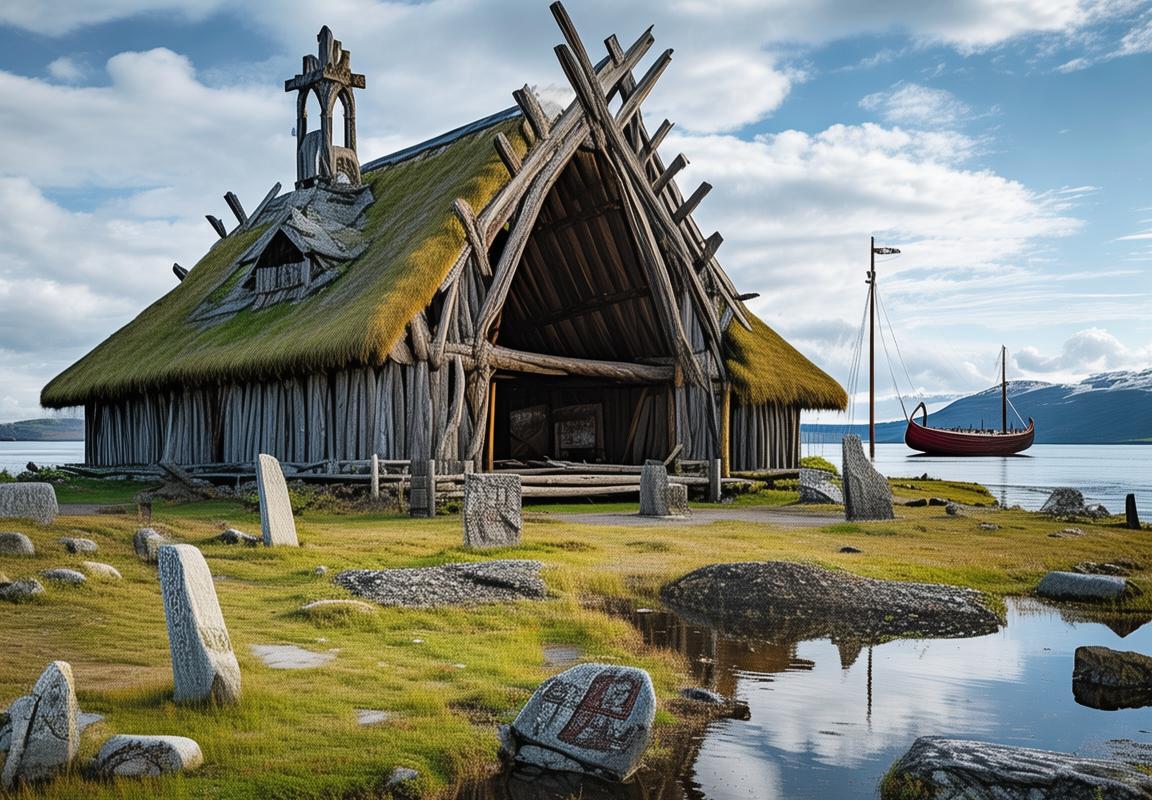
Education and Learning: The Viking Perspective
Vikings were not just warriors, but also innovators and thinkers, as evidenced by their approach to education and learning. 📚
— They valued literacy and the ability to read and write, which was not common among their contemporaries. 📖
— Their society was structured to support the education of its members, with the Church playing a significant role in promoting learning. 🌈
— The Viking educational system was not formalized in the way we understand it today, but it was deeply integrated into daily life. 🌟
— Viking children were taught to read and write from an early age, with runes being the primary script used. 📜
— The runes were more than just a writing system; they were a part of the Viking worldview, linking the physical world with the spiritual. 🌍
— Learning was not confined to the written word; the Vikings also learned through oral traditions, storytelling, and practical experience. 🎤
— The Viking longship, a marvel of engineering, was a testament to their ability to learn and adapt. 🚢
— The Viking settlement of Greenland, with its successful agriculture and trade routes, showed their ability to learn from the environments they inhabited. 🌱
— The Viking Age was marked by a thirst for knowledge, as they traveled to Europe, the Middle East, and beyond, absorbing and integrating new ideas. 🌐
— The Vikings’ interest in trade and exploration led them to learn about different cultures, languages, and technologies. 🌍
— They were also known for their craftsmanship, which was a reflection of their dedication to learning and improvement. 🛠️
— The Viking longhouse, a communal living space, was designed with a focus on practicality and comfort, demonstrating their commitment to learning about living spaces. 🏠
— The Viking Age was a time of cultural exchange, with the Vikings bringing back knowledge from their travels to share with their communities. 🎓
— They were skilled in navigation, astronomy, and mathematics, which were crucial for their survival and success as explorers. 🌟
— The Viking understanding of the natural world was advanced, as they were knowledgeable about plants, animals, and the environment. 🌳
— The Viking tradition of storytelling was a powerful tool for passing on knowledge and cultural values. 📚
— They were also known for their legal codes, which were a reflection of their respect for education and the rule of law. 📜
— The Viking Age was a time of innovation, as they developed new tools and technologies, such as the Battle Axe and the Bow. 🗡️
— Their respect for education was evident in their support for the Church, which was a hub of learning and intellectual exchange. 🌈
— The Viking tradition of education included the concept of the “mead hall,” where scholars and warriors gathered to discuss ideas and share knowledge. 🍻
— The Viking Age was a time of discovery, as they were among the first to explore and map the coastlines of the North Atlantic. 🌊
— Their educational pursuits were not limited to their own culture; they also learned from the peoples they encountered during their travels. 🌍
— The Viking legacy in education is seen in the longevity of their cultural practices, which have influenced modern societies. 🌟
— The Viking understanding of the importance of learning has left a lasting impact on the world, inspiring future generations to seek knowledge. 📚
— Their commitment to education was a cornerstone of their society, and it is a testament to their resilience and adaptability. 🌍
— The Viking legacy in education is a reminder that learning is a journey, not a destination, and that knowledge is a gift to be shared. 🎓
— The Viking perspective on education continues to resonate with us today, as we strive to create a more informed and interconnected world. 🌐
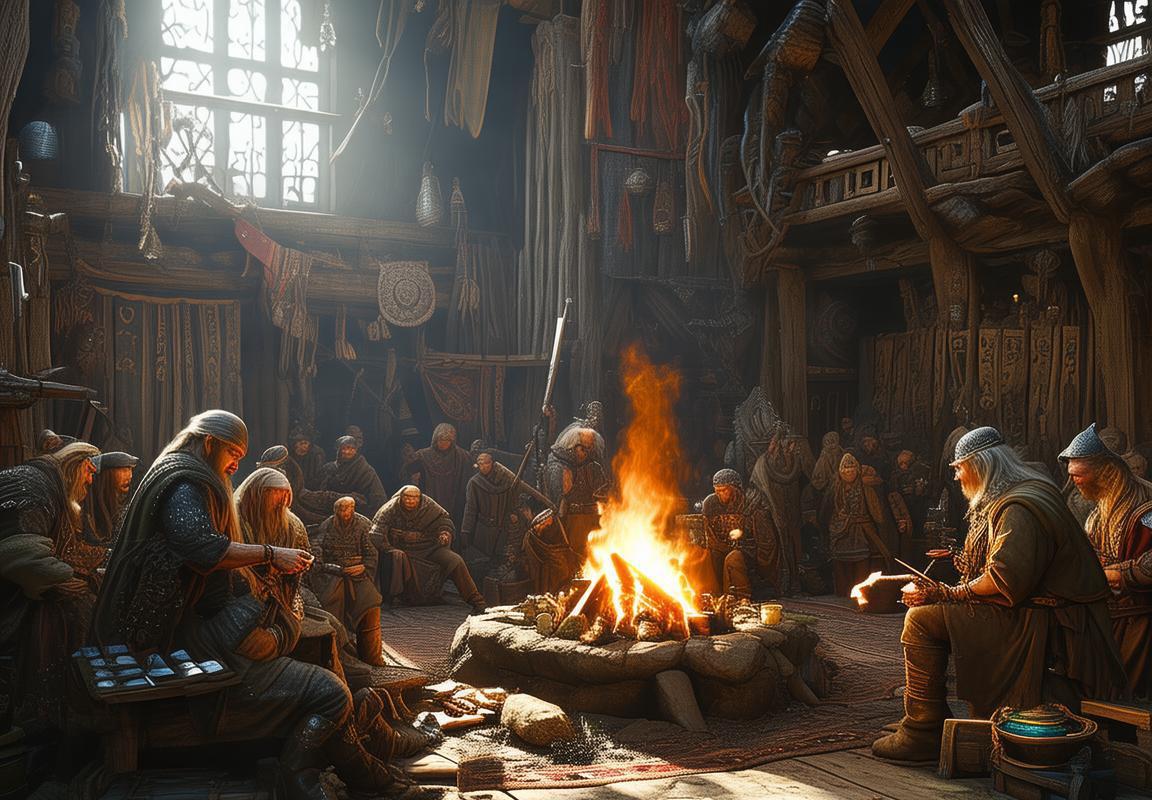
The Legacy of the Volatile Vikings in Today’s World
🌿 The Volatile Vikings have left an indelible mark on the world, their legacy echoing through the ages. Their influence can be seen in various aspects of modern life, from language to law, from culture to cuisine. Here are some of the ways in which the spirit of the Vikings continues to thrive in today’s world.
🏴☠️ The Scandinavian languages, including Danish, Norwegian, and Swedish, bear the traces of the Viking era. Words like “dag,” meaning “day,” and “viking,” itself, are derived from Old Norse, reflecting the era’s impact on the linguistic landscape.
📜 The legal system has also been shaped by Viking practices. The concept of “thing,” or assembly, where disputes were settled, has evolved into modern-day parliamentary systems. The notion of jury trials and the idea of due process have roots in Viking legal traditions.
🏰 In architecture, the Vikings’ ingenuity is evident in the construction of longhouses and the iconic Viking ship. These structures were built to withstand harsh climates and were symbols of power and mobility. Today, the design principles of these ancient buildings inspire modern sustainable architecture.
🌍 The Vikings were renowned explorers, and their adventurous spirit continues to inspire. The concept of exploration is deeply ingrained in modern society, from the space race to the exploration of the ocean depths. The Vikings’ pioneering attitude towards discovery is a testament to their enduring influence.
🤴 The Viking aesthetic has influenced fashion and design. The practicality and durability of Viking clothing, made from materials like wool and leather, have left their mark on contemporary fashion. The rugged charm of Viking-inspired patterns and motifs can be found in modern textiles and fashion.
🏹 Sports and recreation have a Viking connection, too. The Viking game of knattleik, a precursor to modern-day handball, was a popular pastime. This early form of ball sport has contributed to the development of various ball games, including basketball and volleyball.
🏰 Viking artistry is celebrated in the intricate carvings found on their runestones and in the wood carvings of their longhouses. The craftsmanship and symbolism in these works have influenced modern art and design, with a focus on natural motifs and the enduring power of storytelling.
📚 Education and learning were valued by the Vikings, as evidenced by the existence of schools and the copying of manuscripts. The Viking approach to education, emphasizing literacy and the importance of the written word, has paved the way for the modern education system, where the pursuit of knowledge is paramount.
🌱 The Viking legacy is also evident in the way we approach environmental stewardship. The Vikings had a deep respect for nature, and their sustainable practices, such as using renewable resources and managing land responsibly, resonate with today’s emphasis on sustainability and conservation.
🏰 Viking mythology continues to captivate the imagination. Stories of gods like Odin, Thor, and Freya have been adapted into literature, film, and television, keeping the Viking narrative alive. These myths have contributed to the development of modern fantasy genres and have inspired countless works of art and entertainment.
🌍 The Viking spirit of independence and resilience is celebrated in the entrepreneurial culture of today. The Vikings were innovators and traders, and their spirit of enterprise has influenced the global business landscape. The idea of taking risks and seeking new opportunities is a direct descendant of Viking commerce.
📜 The Viking tradition of storytelling has influenced the way we communicate. The oral histories and sagas of the Vikings have been passed down through generations, shaping the narrative traditions of their descendants. This oral tradition has influenced the way we tell stories and share knowledge today.
🌱 The legacy of the Volatile Vikings is a complex tapestry of history, culture, and innovation. From the practicality of their tools to the grandeur of their ships, the Vikings have left an enduring impact on the world. Their legacy continues to inspire and challenge us, reminding us of the power of resilience, adaptability, and the pursuit of knowledge.
Images

















